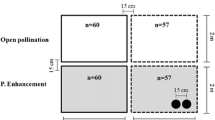Abstract
Caryodendron orinocense Karst. (Euphorbiaceae) is an important neotropical, dioecious crop tree providing oil—and protein-rich seeds. Increases in size and number of leaves, flowers, and fruits were estimated for 100 trees in a plantation in costal Ecuador. Height increase was one meter per year—female trees grew less than non-flowering and male individuals. Trees matured at about 4 m height, but flowering and production of fruits remained low until tree height exceeded 8 m. Flowering and leaf production started at the beginning of the rainy season, and flowers were pollinated by large flies. Foliage damage did not seriously reduce leaf number nor fruit production. The plantation studied yielded 150 kg seeds per hectare per year. A plantation with 10 m high trees and a sex ratio of nine females per male will produce 500 kg seeds per hectare per year after about 12 years. Production will increase much more in older plantations.
Resumen
Caryodendron orinocense Karst. (Euphorbiaceae), es un importante →bol dioico de cultivo neotropical y produce semillas con un alto contenido de aceite y proteínas. Se midió el incremento en tamaño y cantidad de las hojas, flores y frutos en 100 individuos en una plantation en la región costera de Ecuador. El incremento de la altura fue de un metro por año—los arboles femininas crecieron menos que los individuos sin flores y los arboles masculinos. Aunque los árboles maduran cuando alcanzan 4 m de altura, la floración y la producción de frutos permanece baja hasta que el árbol excede los 8 m. La producción de flores y hojas comenzó al principio de la estacion lluviosa, y las flores fueron polinizadas por moscas grandes. El daño en las hojas no reduce seriamente el número de hojas o la productión de frutos. La plantatión estudiada produce 150 kg de semillas por hect→ea y por año. Una plantatión, con árboles de 10 m y una relatión de 9 hembras por macho producirá, despues de unos 12 años, 500 kg de semillas por hectárea y por ańo. La productión se incrementa mucho más en plantaciones más antiguas.
Similar content being viewed by others
Literature Cited
Anonimo. 1957. Monografía del arbol llamado vulgarmente “Cacay”. Agricultura Tropical 13:774–775.
Caldas, R. A. J. 1953. Monografía del árbol llamado vulgarmente “Cacay”. Revista Cafetera de Colombia 11:3997–3998.
Cifuentes, B. L. E., and R. Soto. 1986. Fenología y manejo de postcosecha del “inchi”Caryodendron orinocense Karsten. Masters dissertation, Universidad Nacional de Colombia. Palmira, Colombia.
Duran, M. E. 1986. Primera etapa en el proceso de domestication del generoCaryodendron. Colombia Amazónica 2:15–34.
Duran, M. E. 1988. Observaciones fenológicas del “inchi” o “cacay”Caryodendron orinocense Karsten. Colombia Amazónica 3:113–134.
Feil, J. P. 1992. Reproductive ecology of dioeciousSiparuna (Monimiaceae) in Ecuador—a case of gall midge pollination. Botanical Journal of the Linnean Society 110:171–203.
Franklin, H. G., J. R. Botina P., and J. R. Pérez. 1993. Biologia floral del inchiCaryodendron orinocenseKarsten (Euphorbiaceae). Acta Amazonica—ciencia, technologia y cultura 1:29–44.
Harling, G. 1979. The vegetation types of Ecuador— a brief survey. Pages 89–105In K. Larsen and L. B. Holm-Nielsen, eds., Tropical Botany. Academic Press, London.
Jimenez, L. C, and H. Y. Bernal. 1992. El inchi—Caryodendron orinocense Karsten (Euphorbiaceae). SECAB, Santafe de Bogota, Colombia.
Khatun, S., and T. J. Flowers. 1995. The estimation of pollen viability in rice. Journal of Experimental Botany 46:151–154.
Martinez, S. J. B. 1970. El “inchi” (Caryodendron orinocense Karst.) oleaginosa nativa de América tropical. Universidad del Nariño, Pasto, Colombia.
Melampy, M. N., and H. F. Howe. 1977. Sex ratio in the tropical treeTriplaris americana (Polygonaceae). Evolution 31:867–872.
Reckin, J. 1982. The orinoconut—a promising tree crop for the tropics. The International Tree Crops Journal 2:105–119.
Thomas, S. C, and J. V. LaFrankie. 1993. Sex, size, and interyear variation in flowering among dioecious trees of the Malayan rain forest. Ecology 74: 1529–1537.
van Dijk, K. 1979. El “Cacay” 6 “Inchi” (Caryodendron orinocerise Karsten). Evaluatión del estado de la investigatión de la especie: perspectivas y propuestas para futuras investigaciones. INDERENA, PNUD, FAO, CONIE Col/74/005. PIF No. 24.
Willson, M. F. 1983. Plant reproductive ecology. John Wiley & Sons, London.
Author information
Authors and Affiliations
Corresponding author
Rights and permissions
About this article
Cite this article
Feil, J.P. Pollination biology and seed production of dioeciousCaryodendron orinocense (Euphorbiaceae) in a plantation in coastal Ecuador. Econ Bot 51, 392–402 (1997). https://doi.org/10.1007/BF02861051
Received:
Accepted:
Issue Date:
DOI: https://doi.org/10.1007/BF02861051




